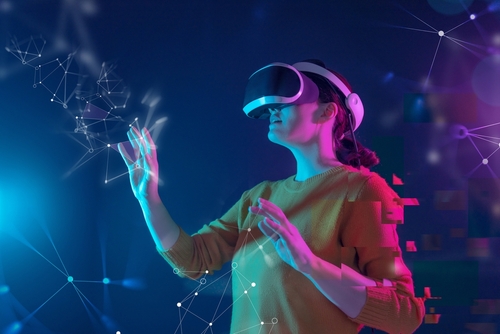Augmented Reality: Revolutionizing Entertainment
Table of contents

The Evolution of Augmented Reality in Technology
Augmented Reality (AR) has made significant strides since its inception, revolutionizing the technological landscape. Initially perceived as a niche innovation, AR has now become pivotal in various industries. The essence of AR lies in its ability to overlay digital information onto the real world, enhancing user experiences in unprecedented ways. In the tech sector, augmented reality is being used to create more immersive user interfaces, assist in complex tasks, and even improve accessibility for individuals with disabilities.
One of the most significant evolutionary steps for AR was its integration into mobile devices. Smartphones and tablets have become primary platforms for AR applications, offering users interactive experiences right at their fingertips. The development of sophisticated AR applications has led to advancements in fields like education, healthcare, and retail. For instance, AR-based medical apps allow surgeons to practice complex procedures in a risk-free, simulated environment, enhancing their skills and patient safety.
Moreover, tech companies continue to invest heavily in AR research, pushing the boundaries of what’s possible. Companies like Apple, Google, and Microsoft are consistently developing AR hardware and software, aiming to make AR a staple in everyday technology. Their innovations in AR glasses and headsets promise to transform how we interact with the digital world, making AR an integral part of daily life.
AR is also increasingly being used in data visualization and analytics. By overlaying data insights on real-world environments, AR provides a more intuitive way to understand complex datasets. This capability is reshaping business strategies and decision-making processes across various industries, showcasing AR’s potential to revolutionize the tech sector.
Augmented Reality: Transforming the Entertainment Industry
In the realm of entertainment, augmented reality is a game changer, offering new ways for audiences to engage with content. From video games to immersive theater experiences, AR is redefining how stories are told and experienced. Video games like Pokémon Go have demonstrated AR’s enormous potential to blend physical and digital play, creating experiences that are not only fun but also socially engaging.
The film industry is also exploring AR to create more interactive and immersive storytelling experiences. Filmmakers are experimenting with AR to offer audiences unique perspectives, allowing them to engage with the narrative in a more personal way. This technology enriches the cinematic experience by offering bonus content, such as character backstories or behind-the-scenes footage, viewable through AR applications.
Live events and concerts are another area where AR is making waves. Artists and event organizers are using AR to create visually stunning and interactive experiences for attendees. With AR glasses or mobile apps, concert-goers can view digital elements that enhance the live performance, from virtual fireworks to interactive stage designs.
The future of AR in entertainment promises to be even more exciting as technology advances. With the development of more sophisticated AR devices and applications, the potential for creating deeply immersive experiences is vast. As AR continues to evolve, it is set to become an integral part of how entertainment is consumed and enjoyed.
Education and Training: Augmented Reality as a Learning Tool
Beyond tech and entertainment, augmented reality is making a significant impact in education and training. AR offers a hands-on learning experience, making complex subjects more accessible and engaging. For educators, AR provides tools to create interactive lessons that captivate students’ attention and foster deeper understanding.
In classrooms, AR is used to bring textbooks to life. Students can interact with 3D models of historical events, scientific phenomena, and more, providing a multi-sensory learning experience that enhances comprehension. This interactive learning approach is particularly beneficial in subjects such as science, where visualizing complex processes can be challenging.
AR is also transforming professional training, providing immersive simulations that allow trainees to practice skills in a realistic yet controlled environment. Industries like aviation, medicine, and manufacturing are leveraging AR to train employees in scenarios that are too dangerous or costly to replicate in real life. This not only improves skill acquisition but also reduces training costs and risks.
As AR technology continues to improve, its applications in education and training are expected to expand. The future will likely see AR becoming a standard tool in educational settings, offering personalized and adaptive learning experiences that cater to individual student needs.
The Future of Augmented Reality
The future of augmented reality is full of possibilities. With ongoing advancements in AR technology, its potential applications are vast and varied. In the coming years, we can expect AR to be integrated into more aspects of daily life, from enhancing mundane tasks to revolutionizing entire industries.
One of the most anticipated developments in AR is the rise of wearable technology. AR glasses and contact lenses are on the horizon, promising to bring augmented reality experiences to new heights. These devices aim to provide seamless integration of digital and physical worlds, offering users an always-on AR experience that is both convenient and intuitive.
Augmented reality is also expected to play a crucial role in the development of smart cities. By overlaying digital information on real-world infrastructure, AR can improve urban planning, enhance public safety, and streamline transportation systems. This integration promises to make cities more efficient, sustainable, and livable.
As AR technology evolves, ethical considerations and challenges will also arise. Issues such as privacy, data security, and digital addiction will need to be addressed to ensure that AR technology is used responsibly and benefits society as a whole.
Conclusion: The Impact of Augmented Reality
Augmented reality is undoubtedly revolutionizing technology and entertainment, offering innovative solutions and experiences that were once thought impossible. From transforming educational methodologies and training to reshaping how we interact with digital content, AR is at the forefront of technological advancement. As we look to the future, the possibilities of augmented reality are infinite, promising to enhance both our personal and professional lives in countless ways.
FAQs about Augmented Reality
**What is augmented reality?**
Augmented reality is a technology that overlays digital information onto the real world, enhancing the user’s perception and interaction with their environment.
**How is AR used in education?**
In education, AR is used to create interactive and immersive learning experiences, making complex subjects more accessible and engaging for students.
**What are some examples of AR in entertainment?**
Examples include AR-enhanced video games like Pokémon Go, immersive theater experiences, and interactive elements in live concerts.
**How does AR benefit businesses?**
AR helps businesses by improving data visualization, enhancing customer experiences, and streamlining training and operational processes.
**What are the challenges of implementing AR?**
Challenges include technological limitations, high development costs, and privacy and security concerns.
**What is the future of AR technology?**
The future of AR includes advances in wearable technology, smart city integrations, and more immersive and interactive applications across various industries.








